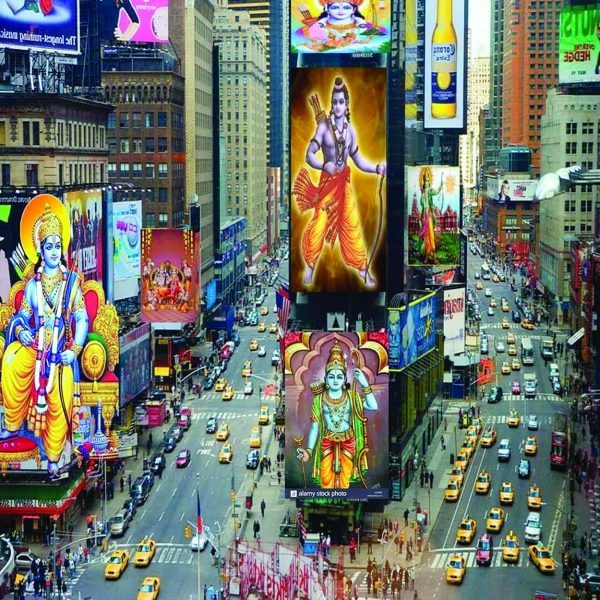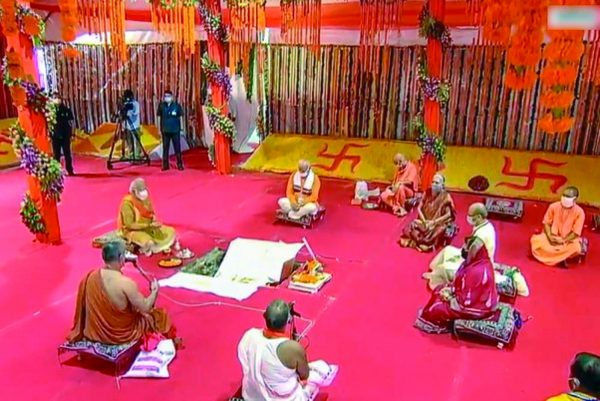Bhoomi Puja in Ayodhya by PM Modi: “Centuries of Wait Has Ended”

Images of Lord Ram in New York City’s Times Square to celebrate the Lord Sri Ram Janmabhoomi Pujan by Prime Minister Narendra Modi in Ayodhya.
Ayodhya: The decades-long wait to see a permanent home for Lord Ram built in Ayodhya, the perceived birthplace of the deity ended on Wednesday, with Prime Minister Narendra Modi laid the foundation stone for the Ram temple on the site in a grand ceremony.
Bhajans and ‘shlokas’ were heard as the Ayodhya, festooned with marigold flowers and yellow and saffron flags, celebrated the beginning of the construction of a grand Ram temple. Roads leading to the holy city were adorned with hoardings of the proposed temple and of Ram Lalla, the infant Ram, the deity now housed in a makeshift temple. Most shops were painted in bright yellow.
Not only was the bhoomi pujan in Ayodhya a reason to celebrate for many in the nation but also signalled the fulfilment of a long-held goal of the Bharatiya Janata Party.
“The wait of centuries has ended and India is creating a golden chapter in Ayodhya,” PM Modi said after performing the bhoomi pujan.
As priests chanted Sanskrit ‘shlokas’ and the ground-breaking ceremony got underway under a giant marquee decorated in shades of reds and yellows, Modi and the other dignitaries, all in masks, maintained social distancing and sat a safe distance away from each other.

Some Ram Janmabhoomi movement leaders, including former deputy prime minister LK Advani, were not at the venue where the organisers had invited only 175 people.
Here is all you need to know about the Ram Mandir Bhoomi Pujan that took place in Ayodhya today:
In a highly-anticipated event watched by millions on television, Prime Minister Narendra Modi laid the foundation of the Ram temple in Ayodhya, the culmination of a campaign that fuelled the rise of the BJP and marked the fulfilment of one of its core poll promises.
Uttar Pradesh Governor Anandiben Patel, Chief Minister Yogi Adityanath, RSS chief Mohan Bhagwat and Shri Ram Janmabhoomi Teerth Kshetra trust head Nritya Gopal Das were on the dais along with the PM.
The prime minister arrived in Ayodhya in a helicopter where Adityanath among others received him.
Before the function to lay the foundation stone of the ‘Shree Ram Janmabhoomi Mandir’, the prime minister took part in prayers at the Hanumangarhi temple. From there, he travelled to the ‘Shree Ram Janmabhoomi’ where he performed prayers at the ‘Bhagwan Shree Ramlala Virajman’.
Amid the chanting of shlokas, Modi consecrated the very first bricks for the temple at the spot where many devout Hindus believe Lord Ram was born. The wait of centuries has ended, he said after performing the groundbreaking ceremony.
Later, the Prime Minister addressed the gathering after the bhoomi pujan. Beginning his speech with “Jai Siya Ram”, PM Modi described Ram as the common thread in India’s unity in diversity and drew a parallel between the country’s independence movement and “centuries” of people’s struggle to build the temple at Ram Janmabhoomi.
The groundbreaking was celebrated with smaller events across the country– from the blowing of a conch at a jewellery shop beyond the barricades in Ayodhya itself to more elaborate rituals in Delhi’s Chattarpur temple complex. Elsewhere people lit diyas to mark the historic occasion.
President Ram Nath Kovind said the foundation-laying ceremony defines India’s spirit of harmony.
“Being built in tune with law, it defines India’s spirit of social harmony and people’s zeal. It will be a testimony to ideals of Ram Rajya and a symbol of modern India,” he tweeted.
Congress leader Rahul Gandhi said Ram is the ultimate embodiment of supreme human values.
“Ram is love, he can never appear in hatred. Ram is compassion, he can never appear in cruelty. Ram is justice, he can never appear in injustice,” he said.
AIMIM chief Asaduddin Owaisi said the prime minister’s participation at the bhoomi pujan went against the Constitution and marked the victory of majoritarianism. “Today is a victory of Hindutva over secularism,” he said. The construction of the temple is designed by the Sompura family and to be built by Larsen & Toubro (L&T) by 2024.
